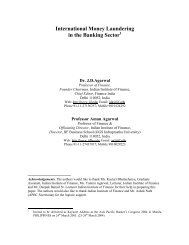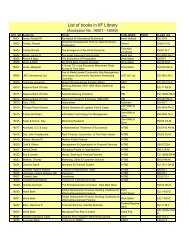Analytical Study of Inventory Management in Punjab State Electricity ...
Analytical Study of Inventory Management in Punjab State Electricity ...
Analytical Study of Inventory Management in Punjab State Electricity ...
Create successful ePaper yourself
Turn your PDF publications into a flip-book with our unique Google optimized e-Paper software.
412 F<strong>in</strong>ance India<br />
FINANCE INDIA<br />
Vol. X No. 2, June 1996<br />
Pages— 412–415<br />
Abstract <strong>of</strong> Doctoral Dissertation<br />
<strong>Analytical</strong> <strong>Study</strong> <strong>of</strong> <strong>Inventory</strong> <strong>Management</strong><br />
<strong>in</strong> <strong>Punjab</strong> <strong>State</strong> <strong>Electricity</strong> Board*<br />
PAWAN KUMAR**<br />
INVENTORIES ARE VIEWED by most <strong>of</strong> the bus<strong>in</strong>ess world as a large<br />
potential role and not as a measure <strong>of</strong> wealth as was prevalent <strong>in</strong> old days.<br />
The <strong>in</strong>ventory stocked <strong>in</strong> excess <strong>of</strong> demand may lead to drastic price cuts,<br />
so as to be saleable before it becomes worthless because <strong>of</strong> obsolescence.<br />
The <strong>in</strong>ventory stocked less than the demand may lead to the bus<strong>in</strong>ess out <strong>of</strong><br />
the market. There is a constant fear <strong>in</strong> the m<strong>in</strong>ds <strong>of</strong> bus<strong>in</strong>essmen because <strong>of</strong><br />
uncerta<strong>in</strong>ty <strong>in</strong> the market situations, whether to stock or not to stock.<br />
With rather tight monetary market, optimisation <strong>of</strong> resources through<br />
proper <strong>in</strong>ventory control becomes one <strong>of</strong> the major challenges for the material<br />
managers <strong>in</strong> every organisation. Widen<strong>in</strong>g gulf between theory and practice<br />
has become remarkable phenomena <strong>in</strong> this age <strong>of</strong> science and technology.<br />
When the frontiers <strong>of</strong> knowledge are widen<strong>in</strong>g and the theory is develop<strong>in</strong>g<br />
at fast rate, the practice is lagg<strong>in</strong>g far beh<strong>in</strong>d. This is probably true about all<br />
branches <strong>of</strong> knowledge and specially true for <strong>in</strong>ventory management area.<br />
The material function <strong>in</strong> power Industry has a dist<strong>in</strong>ct importance as<br />
every power plant, alongwith the transmission and distribution system, is<br />
committed to provide the consumers at his premises, the un<strong>in</strong>terrupted supply<br />
<strong>of</strong> electrical power adequately as and when required ensur<strong>in</strong>g the quality,<br />
reliability and economy <strong>of</strong> supply at the same time with emphasis on overall<br />
economy. The entire power system is one l<strong>in</strong>e process and failure <strong>of</strong> any<br />
vital component <strong>in</strong> the process results <strong>in</strong>to partial or total outage <strong>of</strong> the<br />
Industry. Inventories play essential and pervasive role <strong>in</strong> the power sector.<br />
Problems Studied<br />
In the study, efforts have been made to conduct a detailed analysis <strong>of</strong><br />
<strong>in</strong>ventory management functions <strong>in</strong> the PSEB. For this purpose, detailed<br />
research has been conducted as follows :<br />
1. Exist<strong>in</strong>g purchase system <strong>of</strong> the Board was observed. In which organisation<br />
structure <strong>of</strong> procurement deptt., purchase policies, record relat<strong>in</strong>g to<br />
purchases were analysed.<br />
* The thesis submitted for the award <strong>of</strong> Ph. D. degree <strong>in</strong> 1992 to <strong>Punjab</strong> University, Patiala<br />
under the supervision <strong>of</strong> Pr<strong>of</strong>. R.S. Sachau, Dept. <strong>of</strong> Bus<strong>in</strong>ess <strong>Management</strong>, <strong>Punjab</strong> University,<br />
Patiala.<br />
** Lecturer , PMN College Rajpura, <strong>Punjab</strong>.<br />
Submitted July ’94, Accepted October ’95
Abstract <strong>of</strong> Doctoral Dissertations 413<br />
2. Detail organisation structure <strong>of</strong> stores <strong>of</strong> Controller <strong>of</strong> Stores Deptt.,<br />
were studied. Inventories held <strong>in</strong> the stores, their receiv<strong>in</strong>g, issu<strong>in</strong>g<br />
procedures, techniques <strong>of</strong> stores control adopted by the board were analysed.<br />
3. Treatment given to wastages, spoilage and dead <strong>in</strong>ventory by the stores<br />
were taken.<br />
4. Exist<strong>in</strong>g system <strong>of</strong> <strong>in</strong>ventory control adopted by the board was studied.<br />
5. New <strong>Inventory</strong> control technique applied to improve the efficiency <strong>of</strong><br />
material management department and to reduce cost <strong>of</strong> <strong>in</strong>ventory.<br />
Research Methodology<br />
The relevant data and <strong>in</strong>formation have been collected from primary as<br />
well as from secondary sources. For collection <strong>of</strong> <strong>in</strong>formation detailed<br />
questionnaires perta<strong>in</strong><strong>in</strong>g to raw-material management general and purchase<br />
control as well as stores control specifically were drafted and got filled up<br />
from all the senior personnel and some from supdt. level employees <strong>of</strong> the<br />
material management deptt. <strong>of</strong> the P.S.E.B.<br />
Direct <strong>in</strong>terviews were also conducted from the concerned deptt., <strong>of</strong> the<br />
board. This helped together actual prevail<strong>in</strong>g conditions <strong>of</strong> purchas<strong>in</strong>g,<br />
ma<strong>in</strong>ta<strong>in</strong><strong>in</strong>g and controll<strong>in</strong>g <strong>of</strong> materials/components. Moreover the boards’<br />
thermal power plant, was also visited many times to study the <strong>in</strong>ventory<br />
management systems <strong>in</strong> Ropar thermal power plant.<br />
Major F<strong>in</strong>d<strong>in</strong>gs <strong>of</strong> the Research<br />
The study has been divided <strong>in</strong> 7 chapters. First chapter is related with<br />
‘Introduction’. In this chapter, overall position <strong>of</strong> electricity <strong>in</strong> India has<br />
been mentioned. Then <strong>in</strong>troduction <strong>of</strong> PSEB is expla<strong>in</strong>ed.<br />
Second chapter is titled as ‘Literary Survey <strong>of</strong> <strong>Inventory</strong> <strong>Management</strong><br />
Techniques’. An attempt has been made to summarise and present the theories<br />
and important concepts <strong>of</strong> <strong>in</strong>ventory management. After expla<strong>in</strong><strong>in</strong>g the need<br />
and importance <strong>of</strong> <strong>in</strong>ventory management techniques, some <strong>of</strong> the <strong>in</strong>ventory<br />
management techniques have been expla<strong>in</strong>ed.<br />
Name <strong>of</strong> the third chapter is‘Procurement System <strong>in</strong> PSEB’. Theoretical<br />
concepts <strong>of</strong> purchas<strong>in</strong>g have been discussed <strong>in</strong> the beg<strong>in</strong>n<strong>in</strong>g <strong>of</strong> the chapter.<br />
Then, the procurement system followed by the board has been expla<strong>in</strong>ed.<br />
For the purpose <strong>of</strong> analys<strong>in</strong>g purchase activities, a detailed questionnaire<br />
was prepared and circulated among the employees <strong>of</strong> Central Purchase<br />
Organisation (CPO). 35 questions relat<strong>in</strong>g to purchase activities were asked.<br />
CPO has adopted standardised purchase procedure and the employees <strong>of</strong><br />
CPO are follow<strong>in</strong>g these procedures like mak<strong>in</strong>g comparative statements,<br />
prepar<strong>in</strong>g purchase order and forward<strong>in</strong>g it to suppliers, persu<strong>in</strong>g legal matters<br />
with supplier <strong>in</strong> the court, preparation <strong>of</strong> records, fixation <strong>of</strong> delivery schedules<br />
etc. However, there are other many activities which are to be performed <strong>in</strong><br />
purchase deptt. But these are not performed, if performed, then not adequately<br />
<strong>in</strong> the CPO. Some <strong>of</strong> these are, purchas<strong>in</strong>g records, Purchase Budget<strong>in</strong>g,<br />
suppliers performance and Rat<strong>in</strong>g, Buyer seller Relations (Suppliers Goodwill),
414 F<strong>in</strong>ance India<br />
Evaluation <strong>of</strong> performance <strong>of</strong> Purchase activities, tra<strong>in</strong><strong>in</strong>g to the employees,<br />
purchase research and purchase ethics.<br />
Name <strong>of</strong> the Fourth Chapter is ‘Stores and Stores Control <strong>in</strong> PSEB’. In<br />
the beg<strong>in</strong>n<strong>in</strong>g <strong>of</strong> the chapter, theoretical concepts <strong>of</strong> store keep<strong>in</strong>g have been<br />
discussed. Then store procedures followed <strong>in</strong> the stores <strong>of</strong> controller <strong>of</strong> stores<br />
deptt. are mentioned like receipts, issues, transfer, ma<strong>in</strong>tenance <strong>of</strong> material,<br />
report<strong>in</strong>g system adopted by the stores, security measures adopted <strong>in</strong> the<br />
stores. For the purpose <strong>of</strong> analys<strong>in</strong>g store activities, a details questionnaire<br />
was drafted. In this questionnaire, 38 questions relat<strong>in</strong>g to store activities<br />
were written. A seven po<strong>in</strong>t scale was used for the purpose <strong>of</strong> evaluation <strong>of</strong><br />
store activities. It is concluded that store employees are stress<strong>in</strong>g ma<strong>in</strong>ly on<br />
rout<strong>in</strong>e/ord<strong>in</strong>ary types <strong>of</strong> activities <strong>in</strong> their respective stores like, receipt and<br />
issue <strong>of</strong> materials, <strong>in</strong>ter-store transfer, prepar<strong>in</strong>g rout<strong>in</strong>e reports and records<br />
<strong>in</strong>clud<strong>in</strong>g shortages, damages etc.<br />
Whereas more activities are required for runn<strong>in</strong>g stores efficiently e.g.<br />
efficient material hand<strong>in</strong>g, ma<strong>in</strong>ta<strong>in</strong><strong>in</strong>g various levels <strong>of</strong> <strong>in</strong>ventories,<br />
replenishment <strong>of</strong> stocks <strong>in</strong> stores, measur<strong>in</strong>g efficiency <strong>of</strong> stores, cost reduction<br />
programmes, tra<strong>in</strong><strong>in</strong>g to the store employees, care has not been taken properly<br />
on above mentioned activities <strong>in</strong> store department. Some <strong>of</strong> these activities<br />
we are discuss<strong>in</strong>g here.<br />
Major material handl<strong>in</strong>g activities are performed manually <strong>in</strong> controller<br />
<strong>of</strong> store Department (COS). There are 597 number <strong>of</strong> work charge/Daily<br />
wage workers for material handl<strong>in</strong>g <strong>in</strong> the stores. Total wages paid to these<br />
employees are Rs. 1 crore approximately. Mechanical handl<strong>in</strong>g is done only<br />
for bulky material. Efforts should be made to handle the materials mechanically<br />
so that cost <strong>of</strong> handl<strong>in</strong>g can be reduced.<br />
Only store verification activities are done seriously by store employees<br />
and stock verifiers appo<strong>in</strong>ted by the department <strong>of</strong> Material Service. There<br />
are so many store control techniques which can be used for manag<strong>in</strong>g stores<br />
efficiently. Some <strong>of</strong> these are, <strong>in</strong>ventory turnover ratio, standardisation, levels<br />
<strong>of</strong> <strong>in</strong>ventory, ABC analysis, mak<strong>in</strong>g <strong>in</strong> the stores, storewise replenishment <strong>of</strong><br />
stock etc. So these techniques are suggested for better control <strong>in</strong> the stores<br />
<strong>of</strong> COS deptt. Efforts are also made to calculate storage cost <strong>of</strong> <strong>in</strong>ventory.<br />
The carry<strong>in</strong>g cost <strong>of</strong> COS deptt. is com<strong>in</strong>g 34.6% approximately.<br />
Fifth chapter is framed for analys<strong>in</strong>g <strong>in</strong>ventory management techniques<br />
<strong>in</strong> PSEB. Here efforts are made to apply some more <strong>Inventory</strong> control techniques<br />
for efficient management <strong>of</strong> purchase and store activities <strong>in</strong> material management<br />
department.<br />
<strong>Inventory</strong> Turnover Ratio:- <strong>Inventory</strong> Turnover Ratio <strong>of</strong> 25 Major items<br />
<strong>of</strong> COS deptt. were calculated for the years <strong>of</strong> 1988-89, 1989-90 and 1990-<br />
91 respectively. By compar<strong>in</strong>g different years <strong>Inventory</strong> turnover ratio <strong>of</strong><br />
each item, it is concluded that the stock level <strong>of</strong> each item is not ma<strong>in</strong>ta<strong>in</strong>ed<br />
properly <strong>in</strong> different years by COS deptt.
Abstract <strong>of</strong> Doctoral Dissertations 415<br />
Economic Order Quantity: - (EOQ) The CPO is procur<strong>in</strong>g items worth<br />
Rs. 100 crores every year. The employees <strong>of</strong> the CPO are procur<strong>in</strong>g these<br />
items on the basis <strong>of</strong> their past experience. EOQ <strong>of</strong> 25 major items, have<br />
been calculated. Order cost per order calculated is com<strong>in</strong>g Rs. 8,900.00 and<br />
carry<strong>in</strong>g cost is 34.6%. Total <strong>in</strong>ventory cost <strong>of</strong> 25 major items <strong>of</strong> COS is<br />
com<strong>in</strong>g Rs. 1,00,94,000.00 (approx) by apply<strong>in</strong>g EOQ technique. Whereas<br />
total <strong>in</strong>ventory cost as per PSEB’s purchase procedure for 25 major items,<br />
is com<strong>in</strong>g Rs. 5,36,53,00.00 (approx). There will be sav<strong>in</strong>g <strong>of</strong> more than Rs.<br />
4 ‘Crores’ <strong>in</strong> a year if items are purchased through EOQ system.<br />
Efforts are made to classify store items <strong>in</strong>to A,B. & C category. it was<br />
analysed that only few items are com<strong>in</strong>g under A & B category. 14 items out<br />
<strong>of</strong> 1374 are <strong>in</strong> A category, 56 are <strong>in</strong> B category. So strict policies can be<br />
developed and implemented for controll<strong>in</strong>g A & B category <strong>of</strong> items.<br />
In the study, different policies are developed for A,B & C category <strong>of</strong><br />
items respectively so that the store items can be controlled properly.<br />
The sixth chapter is named as ‘<strong>Inventory</strong> <strong>Management</strong> <strong>in</strong> Thermal Power<br />
Plant’ <strong>in</strong> the study. Ropar Thermal Power Plant is covered under the study.<br />
This chapter has started with some salient features <strong>of</strong> RTP, Ropar. Then the<br />
organisation structure <strong>of</strong> entire plant has been expla<strong>in</strong>ed. After that, procurement<br />
system used <strong>in</strong> the RTP was studied. Store <strong>of</strong> RTP, Ropar were visited and<br />
store activities were analysed, <strong>in</strong> which, activities performed <strong>in</strong> stores, material<br />
handl<strong>in</strong>g systems followed and store control techniques used <strong>in</strong> the stores<br />
were discussed.<br />
As we know coal and oils are the ma<strong>in</strong> <strong>in</strong>puts <strong>of</strong> the Thermal power<br />
plants. So details regard<strong>in</strong>g procurement, ma<strong>in</strong>tenance, issue and handl<strong>in</strong>g <strong>of</strong><br />
coal and oils <strong>in</strong> the RTP has been written. Various records prepared by the<br />
RTP relat<strong>in</strong>g to these <strong>in</strong>puts has also been mentioned <strong>in</strong> the chapter. Different<br />
problems faced by the RTP relat<strong>in</strong>g to coal have been highlighted.<br />
Chapter seventh concludes our study. This chapter <strong>in</strong>tegrates the f<strong>in</strong>d<strong>in</strong>g<br />
and recommendations <strong>of</strong> the study.
















